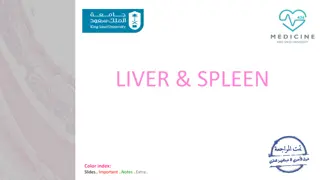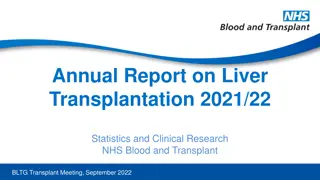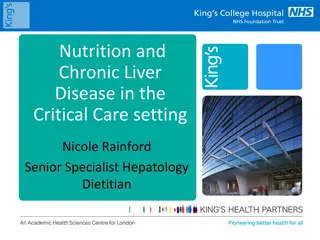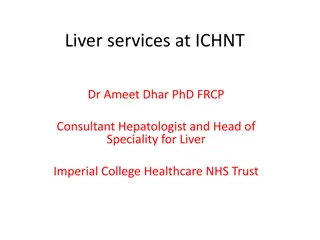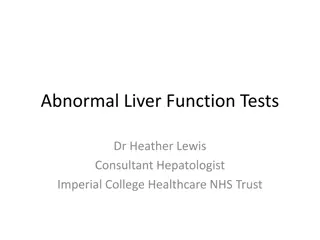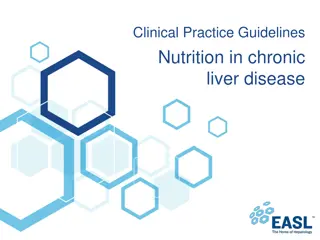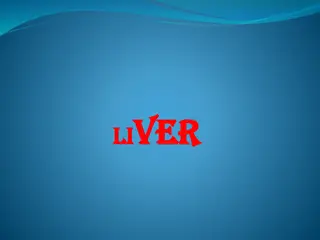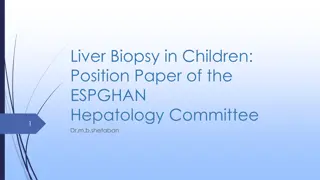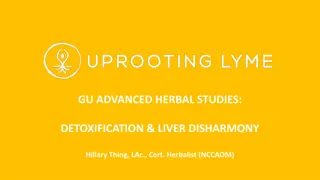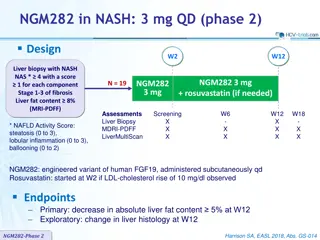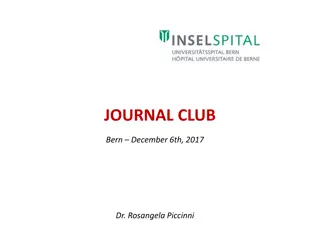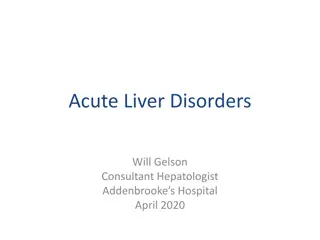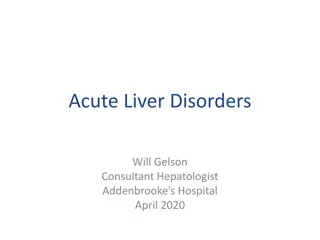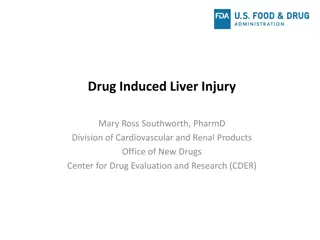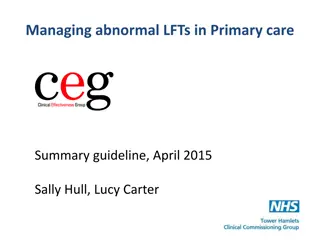Guidance for Patients with COVID-19 and Liver Disease Overview
This guidance provides detailed information on COVID-19 and liver disease, covering topics such as COVID-19 overview, liver test abnormalities, co-morbidities, viral hepatitis B and C, metabolic dysfunction, autoimmune hepatitis, clinical care aspects, complications management, screening for HCC, and liver transplant considerations. It includes insights from various contributors and focuses on practical aspects of care for patients with liver conditions during the COVID-19 pandemic.
Download Presentation

Please find below an Image/Link to download the presentation.
The content on the website is provided AS IS for your information and personal use only. It may not be sold, licensed, or shared on other websites without obtaining consent from the author. Download presentation by click this link. If you encounter any issues during the download, it is possible that the publisher has removed the file from their server.
E N D
Presentation Transcript
WGO Guidance for Patients with COVID-19 and liver disease Contributors* in alphabetical order MR Alvares da Silva, K Burak, T Chen, J Drenth, G Esmat, R Gaspar, D Labrecque, A Lee, G Macedo, B McMahon, Q Ning, N Reau, M Sonderup, DJ van Leeuwen Edited by S Hamid and C Yurdaydin * Members of Hepatology interest group, WGO May 15,2020
Topics COVID-19 and Liver Disease COVID-19 overview, nomenclature General approach if liver test abnormalities Liver co-morbidities Chronic Viral hepatitis B and C Metabolic dysfunction associated fatty liver disease (MAFLD) Autoimmune hepatitis Practical aspects clinical care Follow-up if chronic liver disease Performing Procedures Investigational therapies, potential hepatotoxicity Management of complications Screen and treatment for HCC Patients awaiting and after liver transplant
COVID-19:Overview and nomenclature B Mc Mahon (USA) APRIL 22, 2020
Viral Characteristics SARS-Cov-2 - 1 Coronaviruses: positive-sense 30,000 bp, single stranded RNA viruses 7 strains in wild animals and humans: to date some strains only in wild animals Can jump from animals to humans causing disease (e.g. MERS, SARS, COVID-19) Alphacoronaviruses can cause mild illnesses (common cold or influenza like symptoms) SARS-CoV-2 is strain resulting in COVID-19 (betacoronavirus): Betacoronaviruses can be divided into two groups MERS similar structural viruses SARS and SARS-CoV-2 COVID-19 is the name for the illness caused by SARS-CoV-2. Elifiky AA. Life Sciences 2020. in Press
Viral Characteristics of SARS-CoV-2 -2 RNA dependent RNA polymerase (RdRp) site highly conserved. RdRp of SARS-CoV-2 closest strain to SARS RdRp with 90% sequence identity values vs. 57% to MERS. SARS-CoV-2 first identified in Wuhan, China, now pandemic. At the latest count, it has caused more than 5 million infections and over 300,000 deaths globally. (May 26, 2020) Mortality due to the coronaviruses: SARS 10% MERS 30% SARS-CoV-2- unknown but could range from << 1-2% to as high as 4-5% - 20% or more in elderly persons with co-morbid conditions
CoV Replication and Life Cycle Entry and Uncoating Virus enter the cells through acid- dependent membrane fusion Spike . Attachment Virus Spike protein attaches to ACE2 on cell surface as an entry receptor Production of Virus Particles ACE2, the cell s receptor Translation Viral translation with host ribosomes into polyproteins New Virion Assembly Mature virions form at host ER/Golgi compartment (+) Release of Virus Ribosomes Proteolysis PLpro and 3CLpro cleave polyproteins into ~20 non-structural and structural proteins RdRp Proteases PLpro & 3CLpro Type II Pneumocyte RNA Replication (+) Viral genome replication by RdRp RdRp (+) New viral genome (+) (+) Liu W, et al. Chembiochem. 2020 Mar 2;21(5):730-738. doi: 10.1002/cbic.202000047. Epub 2020 Feb 25.de Wit et al, Nature Reviews Microbiology 2016
Role of ACE-2 in COVID-19 Viral entry into cell Downregulation in lungs by virus leads to: Reduced Ang 1-7 > Reduced lung protection Increased Ang-II > Increased lung injury
General Approach to the Patient with COVID-19 and elevated liver enzymes D.J. van Leeuwen (USA/Rwanda) Q Ning (China) A Lee (Australia) APRIL 22, 2020
Liver test abnormalities in COVID-I9 Incidence range from 14-76% from mild, transient increase to (very rare) severe hepatitis ALT and AST increase most commonly reported Bilirubin increased in about 10% cases. GGT increased in about 50% cases. Guan WJ, N Engl J Med 2020; Fan Z, Clin Gastroenterol Hepatol 2020; Cai Q, J Hepatol 2020.
Published early studies Bangash MN et al, Lancet, 2020 Elevated lactate dehydrogena se, creatinine kinase, or myoglobin Aspartate aminotransferase (IU/L) Alanine aminotransferase (IU/L) Patients (N) Prothrombin time (s) Bilirubin ( mol/L) Mortality (%) Group ICU or death 22% (day 51) 38% (day 37) 11% (day 24) 17% (day 34) 5% (day 50) 0% (day 34) 67 Not known Not known Not known Not known Yes Guan et al (2020) 12 2 (11 2 13 4) 14 0 (11 9 32 9) ICU 13 49 (29 115) 44 (32 70) Yes Huang et al (2020) Hospitalised 99 39 (22 53) 34 (26 48) 11 3 (1 9) 15 1 (7 3) Yes Chen et al (2020) 13 2 (12 3 14 5) ICU 36 35 (19 57) 52 (30 70) 11 5 (9 6 18 6) Yes Wang et al (2020) Hospitalised 81 46 (30) 41 (18) 10 7 (0 9) 11 9 (3 6) Unclear Shi et al (2020) Hospitalised 62 22 (14 34) 26 (20 32) Not known Not known Unclear Xu et al (2020) Not described62% ICU 52 Not known Not known 12 9 (2 9)* 19 5 (11 6)* Yang et al (2020) (day 28) Chronic liver disease Extracted from all studies above 42 Not known Not known Not known Not known Not known 0 2%
Liver test abnormalities and severity of COVID- I9 May be more common in patients with severe systemic disease. Increases in ALT and AST usually not > 3 x ULN. Increase in AST (>40 IU/L) associated with higher mortality (52%) compared to those who recover (16%). Low serum albumin levels (<32 g/L) associated with high mortality*. In critically ill patients (ICU), multi-causality common Significantly abnormal tests: Transaminases > 3-5x ULN, bilirubin > 3 ULN: Other causes become more likely *Chen T, BMJ 2020
Liver test abnormalities in COVID- I9 (mostly addressed in following contributions) Risk if NASH/Obese? See section on MASH Increased risk if alfa-1-antitrypsin deficiency with pulmonary disease? (no reports yet) Safety of augmentation therpay likely okay, subgroups with liver /lung transplant Myositis : (AST > ALT, CPK) (Mao et al, 2019) ICU patients: Abnormal liver enzymes often multi-causal Experimental therapy may lead to drug toxicity Immune modulators: for better for worse? (Suzman et al, 2018)
Pathogenesis of liver abnormalities in COVID-19 ACE 2 receptors on cholangiocytes, to lesser extent on hepatocytes. Direct injury plausible, no data to support this until recently (see below). Limited biopsies with non specific findings of steatosis and acute hepatitis, hepatocyte apoptosis with lobular lymphohistocytic inflammation without viral inclusions*. However, recently ultrastructural and histological changes indicative of viral hepatitis including typical coronavirus particles characterized by spike structure in cytoplasm of hepatocytes in 2 patients** Consider drug induced liver injury, hypoxic hepatitis and role of overactive immune mediated pro-inflammatory response. Incidental finding of preexisting liver/biliary tract disease? *Xu Z, Lancet Respir Med. 2020, **Wang Y et al, J Hepatol 2020
Interpretation of tests Hypoalbuminemia Typical in patients with severe inflammatory response (no independent indicator of liver failure) Prolonged INR /thrombocytopenia Spontaneous coagulopathy DIC in 1/3 of sick patients may explain prolonged PT / INR (1) Thromboembolic events likely common in COVID19 High transaminases/ Bilirubin (> 3 x ULN) Rarely reported: consider other causes Anemia GI bleeding likely? Ulcer, Variceal hemorrhage? Imaging If no or inadequate imaging done , US may be indicated: CBD obstruction, suspected advanced disease Tumor/thrombosis Klok FJ, 2020, Hemostasis Research






